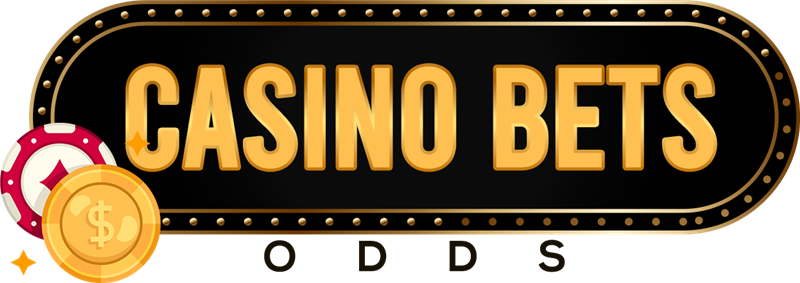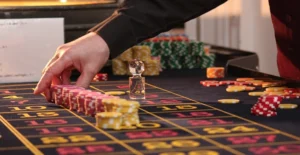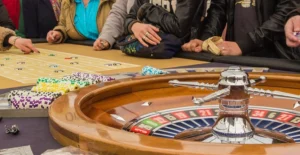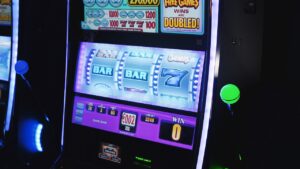Three Card Poker is a popular casino game, mixing traditional poker with a simple table game feel. While it’s pretty easy to get the hang of, actually winning more often means you need to do more than just hope for good luck. This article will go into some tips and tricks that can give you a better chance in Three Card Poker, helping you make smarter choices and maybe even win more.
Key Takeaways
- Always play your hand if you have a Queen, 6, 4, or better. If your hand is weaker, it’s usually best to fold.
- Side bets like Pair Plus and Six-Card Bonus often have worse odds for you. It’s generally smarter to avoid them.
- Know the rules and pay tables well. Understanding these things helps you make better decisions.
- Manage your money wisely. Don’t chase losses by betting more, and stick to your plan.
- Practice the game in free modes before playing with real money. This helps you get comfortable and test strategies.
Three Card Poker: Rules and Gameplay
Three Card Poker is a simplified version of poker that’s become a casino favorite. It’s fast-paced and easy to learn, making it appealing to both new and experienced gamblers. The game involves comparing your three-card hand against the dealer’s, with a few twists that make it unique. The goal is to have a higher-ranking hand than the dealer, but the dealer must also “qualify” for the hand to play out fully.
Here’s a breakdown of how a typical round unfolds when playing three-card poker in casinos:
- Ante Bet: Before any cards are dealt, you place an initial bet called the “Ante.” This is your entry fee into the round.
- Dealing: Both you and the dealer receive three cards face down.
- Decision Time: After looking at your hand, you have two choices:
- Play: If you think you can beat the dealer, you place a “Play” bet equal to your Ante bet.
- Fold: If you don’t like your hand, you fold, forfeiting your Ante bet.
- Dealer’s Hand: The dealer reveals their hand. To “qualify,” the dealer needs a Queen-high or better. This means the dealer’s hand must contain at least a Queen, along with two other cards.
- Showdown: The outcome depends on whether the dealer qualifies and the relative strength of your hand:
- Dealer Doesn’t Qualify: If the dealer doesn’t have a Queen-high or better, your Ante bet is paid out at 1:1, and your Play bet is returned.
- Dealer Qualifies: If the dealer qualifies, your hand is compared to the dealer’s hand. If your hand is better, both your Ante and Play bets are paid out at 1:1. If the dealer’s hand is better, you lose both bets. If the hands are of equal rank, you push (tie) and your bets are returned.
It’s important to remember that the hand rankings in Three Card Poker are slightly different from traditional poker. For example, a straight is ranked higher than a flush.
Understanding these basic rules is the first step toward developing a solid three-card poker strategy. From there, you can start to learn about hand rankings, odds, and optimal betting strategies to improve your chances of winning.
Understanding Hand Rankings and Odds in Three-Card Poker
It’s important to understand the hand rankings and probabilities in Three Card Poker if you want to improve your game. Knowing which hands are strong and how often they occur will help you make better decisions about when to play and when to fold. Let’s break down the essentials.
Hand Rankings in Detail
Three Card Poker uses a slightly different hand ranking system than traditional five-card poker. Here’s the order, from best to worst:
- Straight Flush: Three cards in sequence, all of the same suit.
- Three of a Kind: Three cards of the same rank.
- Straight: Three cards in sequence, but not of the same suit.
- Flush: Three cards of the same suit, but not in sequence.
- Pair: Two cards of the same rank.
- High Card: When you have none of the above, the highest card determines the hand’s rank.
Decoding the Odds
Understanding the three-card poker odds is key to making informed decisions. Some hands come up more often than others, which affects how aggressively you should play them. For example, straights and flushes are rarer than pairs, making them more valuable.
Here’s a look at the approximate probabilities of different hands:
- Straight Flush: 0.20%
- Three of a Kind: 0.24%
- Straight: 3.26%
- Flush: 4.96%
- Pair: 16.94%
- High Card: 74.39%
The Importance of Probabilities
Knowing these probabilities helps you assess the strength of your hand relative to what your opponent might have. If you hold a flush, you know it’s a relatively strong hand compared to the average hand dealt. This knowledge informs your betting strategy.
Understanding the probabilities associated with each hand ranking is not just about knowing which hands are rare; it’s about understanding the likelihood of improving your hand and the potential value you can extract from it.
Identifying the Best Hands
Knowing the best hands in three-card poker is crucial. While a straight flush is the ultimate goal, it’s important to recognize the value of hands like straights and flushes, which occur more frequently. A strong understanding of hand rankings and probabilities will significantly improve your decision-making at the table.
Why Strategy Matters: Minimizing the House Edge
In Three Card Poker, luck plays a role, but smart play is what separates winners from losers. Understanding and applying a solid strategy is key to shrinking the house edge, which is the casino’s statistical advantage. The lower the house edge, the better your chances of walking away with a profit. Ignoring strategy and playing randomly significantly increases the house edge, handing more money to the casino over time. It’s like this: you wouldn’t go into a test without studying, right? Same idea here.
A well-thought-out strategy gives you the best possible chance to win in the long run.
Think of the house edge as a tax on every bet you make. A good strategy is like finding loopholes to lower that tax. It doesn’t eliminate it, but it makes a huge difference.
Understanding the House Edge
The house edge represents the percentage of each bet that the casino expects to keep over the long term. In Three Card Poker, the house edge varies depending on the specific rules and pay tables used by the casino, as well as your playing strategy. For example, blindly raising every hand results in a much higher house edge than using the Queen 6 4 strategy. Knowing the easiest casino game to win is the first step.
The Impact of Strategic Decisions
Every decision you make at the Three Card Poker table affects the house edge. Choosing when to play and when to fold, understanding hand rankings, and avoiding sucker bets all contribute to minimizing the casino’s advantage. A disciplined approach, based on sound mathematical principles, can significantly improve your odds.
Key Strategic Elements
- Selective Play: Don’t play every hand. Fold when your hand is weak. This is the most important thing.
- Optimal Raising: Raise only when your hand meets specific criteria, like the Queen 6 4 rule.
- Side Bet Avoidance: Steer clear of Pair Plus and other side bets, which typically have a much higher house edge.
Comparing Strategies
Different strategies result in different house edges. Here’s a quick comparison:
| Strategy | House Edge (Approximate) |
| Random Play | 7.65% |
| Mimic the Dealer | 3.45% |
| Queen 6 4 Strategy | 3.37% |
As you can see, using a defined strategy like the Queen 6 4 strategy can significantly reduce the house edge compared to playing randomly. This means more money in your pocket over time. Understanding when to fold or play is crucial.
The Queen 6 4 Strategy: When to Play and When to Fold
The Queen 6 4 strategy is the cornerstone of playing Three Card Poker with any degree of seriousness. It’s a simple rule that dictates when you should raise (continue playing) and when you should fold (give up your ante bet). Understanding and applying this strategy is the first step toward minimizing the house edge and improving your chances of winning.
The basic premise is this: if your hand is Queen-6-4 or better, you raise. If it’s worse, you fold.
But what does “Queen-6-4 or better” actually mean? Let’s break it down.
Understanding “Queen-6-4 or Better”
“Queen-6-4 or better” refers to any hand that is at least as good as a hand containing a Queen, a 6, and a 4, regardless of suit. Here’s how to determine if your hand qualifies:
- Start with the highest card: If your highest card is higher than a Queen (i.e., King or Ace), your hand is automatically “better” and you should raise.
- If your highest card is a Queen: Compare your second-highest card to a 6. If it’s higher than a 6, your hand is “better” and you should raise. If it is a 6, then you must compare your third card to a 4. If it’s higher than a 4, your hand is “better” and you should raise.
- If your highest card is lower than a Queen: Your hand is automatically worse than Queen-6-4, and you should fold. This is where many new players make mistakes, hoping for a lucky draw. Don’t do it!
To illustrate, here are some examples:
- Q-7-3: Raise. The Queen is the same, but 7 is higher than 6.
- Q-6-5: Raise. The Queen and 6 are the same, but 5 is higher than 4.
- Q-5-2: Fold. The Queen is the same, but 5 is lower than 6.
- J-K-2: Fold. The highest card (King) is not a Queen, and is lower than a Queen.
Why This Strategy Works
The Queen 6 4 strategy isn’t arbitrary. It’s based on mathematical analysis of the game’s probabilities. By consistently raising with Queen-6-4 or better, you’re only playing hands that have a reasonable chance of beating the dealer’s hand. Folding with worse hands minimizes your losses in the long run. It’s all about playing the odds and making informed decisions. The blackjack strategies are similar in that they are based on mathematical probabilities.
While it might seem boring to fold so often, remember that gambling is a marathon, not a sprint. Consistent, disciplined play is far more likely to lead to success than chasing every hand with reckless abandon.
Deviations from the Queen 6 4 Strategy
While the Queen 6 4 strategy is generally considered optimal, there are some very specific situations where you might consider deviating. These situations usually involve collusion with the dealer (which is illegal and unethical) or taking advantage of specific casino promotions. For the vast majority of players, sticking to the Queen 6 4 strategy is the best approach. Don’t try to get too fancy unless you know what you’re doing. Remember, the goal is to minimize the house edge, not to impress anyone with your supposed gambling prowess. The optimal strategy in ante and play is to raise if you have a queen/6/4 or greater, regardless of the bonus pay table. Overall, the player stands to lose 8.66% of the Ante but win5.29% on the Raise.
Hands Worth Playing: Identifying “Q 6 4 or Better”
Okay, so you’re at the table, cards are dealt, and now you gotta decide: play or fold? This is where the “Q 6 4 or better” strategy comes in. It’s the bread and butter of basic Three Card Poker strategy, and understanding it is key to not bleeding chips unnecessarily. Basically, it’s a guideline to help you make the most profitable decision in the long run.
The core idea is simple: if your hand is Queen, 6, 4, or better, you raise. If it’s worse, you fold. But what does “better” actually mean?
Let’s break it down:
- Queen High: Your highest card is a Queen.
- 6: Your second-highest card is a 6.
- 4: Your third-highest card is a 4.
So, a hand like Q-7-2 is better than Q-6-4 because 7 is higher than 6. Similarly, Q-6-5 is also better. But Q-5-4? That’s a fold.
It’s important to remember that in poker, hands are ranked by their highest card first, then the second-highest, and so on. So, even if you have a pair of twos, but your highest card is lower than a Queen, 6, or 4, you should still fold.
Think of it like this: you’re trying to minimize your losses. Folding might feel like you’re giving up, but it’s often the smartest move. Playing hands worse than Q-6-4 increases the house edge, meaning you’re more likely to lose money over time. Sticking to this strategy helps you stay in the game longer and gives you a better chance of hitting those bigger hands.
Now, some people might suggest raising on any Queen or better, mimicking the dealer’s qualification requirement. While it’s not the worst strategy, it’s not optimal. The house edge is higher compared to sticking with the Q 6 4 strategy. Playing blind, or raising on everything, is even worse, significantly increasing the house edge.
Here’s a simple way to think about it:
- Identify your highest card. Is it a Queen or higher?
- If yes, check your second-highest card. Is it a 6 or higher (if your highest card is a Queen)?
- If yes again, check your third-highest card. Is it a 4 or higher (if your highest cards are Queen and 6)?
- If you answered yes to all, raise. Otherwise, fold.
It takes a little practice, but once you get the hang of it, identifying those playable hands becomes second nature. And that’s when you start playing smarter, not harder, at the Three Card Poker table.
Avoiding Side Bets: Why Pair Plus & Six-Card Bonus Hurt Your Odds
Three Card Poker offers a few tempting side bets, most notably Pair Plus and the Six-Card Bonus. While the prospect of a quick payout is attractive, it’s important to understand that these bets significantly increase the house edge. Focusing on the main Ante and Play bets and using a solid strategy gives you a much better chance of winning in the long run.
The Allure (and Danger) of Side Bets
Side bets like Pair Plus and the Six-Card Bonus offer the potential for large payouts based on the strength of your hand, independent of the dealer’s hand. This can be exciting, but it comes at a cost. The odds are structured in such a way that the casino has a much larger advantage on these bets compared to the main game. It’s easy to get drawn in by the possibility of a big win, but remember that these bets are designed to be profitable for the house, not the player.
Understanding the House Edge
The house edge represents the casino’s average profit from each bet made. A higher house edge means that, over time, you’re likely to lose more money. The Ante and Play bets in Three Card Poker, when played with a sound strategy like the Queen 6 4 rule, have a relatively reasonable house edge. However, side bets like Pair Plus can more than double that edge, significantly decreasing your odds of winning.
Pair Plus: A Closer Look
The Pair Plus bet pays out if your hand contains a pair or better, regardless of the dealer’s hand. While this sounds appealing, the paytable is structured to give the casino a significant advantage. The house edge on Pair Plus can vary depending on the specific paytable, but it’s generally much higher than the main game. It’s important to check the paytable before placing this bet.
Six-Card Bonus: Even Worse Odds
The Six-Card Bonus combines your three cards with the dealer’s three cards to make the best possible five-card poker hand. Payouts are awarded for hands like three-of-a-kind or better. While the potential payouts can be large, the odds of hitting a qualifying hand are very low, resulting in a very high house edge. This bet is generally considered to be one of the worst bets you can make in the casino.
Why to (Mostly) Avoid Them
Here’s why you should generally avoid side bets:
- Higher House Edge: As mentioned, side bets significantly increase the casino’s advantage.
- Increased Volatility: Side bets introduce more variance into your game, meaning your bankroll can fluctuate more wildly.
- Distraction from Core Strategy: Focusing on side bets can distract you from playing the main game optimally.
While the allure of a quick win can be tempting, consistently making side bets will likely deplete your bankroll faster than sticking to the main game with a solid strategy. Discipline is key to long-term success.
Exceptions (and When to Consider Them)
There might be very rare situations where a specific promotion or enhanced paytable makes a side bet temporarily advantageous. However, these situations are uncommon. Always do the math and understand the true odds before placing any side bet. In most cases, your best bet is to stick to the main game and focus on playing a smart, strategic game of Three Card Poker.
When (and If) to Use Pair Plus or Ante Bonus Bets
These side bets – Pair Plus and Ante Bonus – can add excitement to Three Card Poker, but they also significantly impact your odds. It’s important to understand when, or if, they should be part of your strategy. Let’s break down each bet.
Understanding the Pair Plus Bet
The Pair Plus bet is a wager that your own three-card hand will contain at least a pair or better. The payout is based solely on your hand, regardless of the dealer’s hand. While this sounds appealing, it comes with a higher house edge than the standard Ante and Play bets. The Pair Plus bet can be tempting if you’re looking for a quick, potentially large payout without needing to beat the dealer.
Here’s a typical Pair Plus payout table:
| Hand | Payout |
| Straight Flush | 40:1 |
| Three of a Kind | 30:1 |
| Straight | 6:1 |
| Flush | 3:1 |
| Pair | 1:1 |
Keep in mind that the house edge on Pair Plus is generally around 7.28%, depending on the specific pay table. This is considerably higher than the house edge for playing the basic Ante bet with optimal strategy.
Evaluating the Ante Bonus Bet
The Ante Bonus bet pays out a bonus on strong hands (straight or higher) when you also make the Ante bet, regardless of whether the dealer qualifies or if you beat the dealer’s hand. This can be an attractive option, but it’s crucial to examine the pay table. The payouts for the Ante Bonus can vary significantly between casinos, directly affecting the house edge.
The Ante Bonus can be a decent option if the paytable is favorable. Look for tables that offer higher payouts for strong hands like a Straight Flush or Three of a Kind. If the payouts are low, it’s best to avoid this bet.
Factors to Consider
Before placing either of these bets, consider these points:
- Your Risk Tolerance: Are you comfortable with a higher house edge for the chance of a bigger payout?
- The Pay Table: Always check the specific payouts offered by the casino. Favorable pay tables can make these bets more attractive.
- Bankroll Management: These bets can deplete your bankroll faster due to the higher house edge. Set limits and stick to them.
When to Consider These Bets
While generally not recommended for consistent winning, there are situations where these bets might be considered:
- Chasing a Big Win: If you’re willing to take a risk for a potentially large payout, the Pair Plus bet could be an option.
- Favorable Pay Table: If you find a casino with a particularly generous pay table for the Ante Bonus, it might be worth considering.
- Short Sessions: If you’re only playing for a short period, the higher variance of these bets might be acceptable.
Ultimately, the decision to use Pair Plus or Ante Bonus bets depends on your personal preferences and risk tolerance. However, it’s essential to understand the odds and potential drawbacks before placing these wagers. Remember to practice good bankroll management and make informed decisions.
How to Evaluate Pay Tables: Choosing the Best Game
Okay, so you’re ready to play Three Card Poker. But before you jump into the first game you see, it’s important to understand that not all games are created equal. The pay tables, which dictate how much you get paid for different hands, can vary significantly from casino to casino, or even from table to table within the same casino. Learning how to read and evaluate these pay tables is a key skill that can directly impact your winnings. It’s like shopping around for the best deal – you wouldn’t buy the first car you see without comparing prices, right? Same goes for Three Card Poker!
Let’s get into how to make sure you’re playing the best game possible.
Understanding the Ante Bonus Pay Table
The Ante Bonus is a payout you receive if you make the ante bet and have a qualifying hand, regardless of whether the dealer qualifies or if you even beat the dealer. The standard qualifying hands are a straight, three-of-a-kind, or a straight flush. However, the payouts for these hands can differ. You’ll want to look for tables that offer higher payouts for these hands, as this directly reduces the house edge.
Here’s what to look for:
- Payout for Straight Flush: This is the big one. Some tables pay 5:1, while others pay 4:1 or even 3:1. Always go for the higher payout.
- Payout for Three of a Kind: This usually pays 4:1, but some tables might offer only 3:1. Again, higher is better.
- Payout for Straight: This is typically 1:1, but it’s worth checking to be sure.
It’s easy to get caught up in the excitement of the game, but taking a few minutes to compare the Ante Bonus pay tables can save you money in the long run. Don’t be afraid to walk around and check different tables before settling down to play.
Pair Plus Pay Tables: Spotting the Differences
The Pair Plus bet is a side bet that you can make in addition to the ante bet. It pays out based on the hand you’re dealt, regardless of the dealer’s hand. The payouts for Pair Plus can vary widely, and some pay tables are significantly better than others. Finding the best Pair Plus pay table is essential if you plan on making this bet.
Here’s a quick comparison of a good and a bad Pair Plus pay table:
| Hand | Good Pay Table | Bad Pay Table |
| Straight Flush | 40:1 | 30:1 |
| Three of a Kind | 30:1 | 25:1 |
| Straight | 6:1 | 4:1 |
| Flush | 4:1 | 3:1 |
| Pair | 1:1 | 1:1 |
As you can see, the “Good Pay Table” offers significantly higher payouts for the premium hands. Over time, these higher payouts can make a big difference in your overall results.
House Edge and Expected Value: The Numbers Game
Ultimately, the best way to evaluate a pay table is to look at the house edge and expected value. The house edge is the percentage of each bet that the casino expects to win in the long run. The lower the house edge, the better the game is for the player. The expected value is the amount you expect to win or lose on each bet, on average. A positive expected value means you expect to win, while a negative expected value means you expect to lose.
- Look for games with the lowest house edge. This information is often available online or in gambling books. A difference of even a fraction of a percent can add up over time.
- Understand the impact of different pay tables on the house edge. Some pay tables significantly increase the house edge, making the game much less favorable.
- Don’t be afraid to ask casino staff for information about the pay tables and house edge. They may not always be forthcoming, but it’s worth a try.
It’s important to remember that even the best pay table still has a house edge. Three Card Poker is a game of chance, and there’s no guarantee that you’ll win. However, by carefully evaluating the pay tables and choosing the best game, you can improve your odds and increase your chances of walking away a winner.
Bankroll Management and Betting Discipline for Casino Play
Playing Three Card Poker in a casino can be a thrilling experience, but it’s easy to get carried away. That’s why having a solid plan for managing your money and sticking to it is super important. Without it, you might find yourself making bad decisions and losing more than you intended. Let’s break down how to keep your bankroll safe and your betting under control.
Setting a Budget and Sticking To It
Before you even step foot in the casino, decide how much money you’re willing to risk. This is your bankroll, and it should be an amount you can afford to lose without causing financial stress. Once you’ve set your budget, stick to it no matter what. Don’t be tempted to dip into other funds or chase losses. Think of it as entertainment money, and once it’s gone, the game is over for the day.
Determining Your Stake Size
Your stake size is how much you bet on each hand. A good rule of thumb is to keep your stake size small relative to your overall bankroll. This helps you weather any losing streaks and stay in the game longer. For example, if you have a $200 bankroll, consider betting $5 or $10 per hand. This gives you a decent number of hands to play and a better chance of hitting a winning streak.
Avoiding Tilt and Emotional Betting
Tilt is a poker term that refers to a state of frustration or anger that leads to poor decision-making. It’s easy to get tilted when you’re losing, but it’s important to stay calm and rational. Don’t let your emotions dictate your bets. If you find yourself getting upset or frustrated, take a break from the game. Clear your head, and come back when you’re feeling more level-headed. Remember, emotional betting is a surefire way to lose money.
Knowing When to Quit (Win or Lose)
Knowing when to walk away is just as important as knowing when to play. Set a win limit and a loss limit before you start playing. If you reach your win limit, cash out and enjoy your profits. If you reach your loss limit, stop playing and accept the loss. Don’t be tempted to keep playing in the hope of winning back your losses or increasing your winnings. This is a common mistake that can lead to bigger losses. It’s better to walk away with some money in your pocket than to lose it all.
Bankroll management isn’t just about limiting losses; it’s about maximizing your enjoyment of the game. By setting clear boundaries and sticking to them, you can play with confidence and avoid the stress of financial risk. It’s a key skill that separates casual players from serious gamblers.
Using Betting Units
Instead of thinking in terms of dollars, think in terms of betting units. A betting unit is a fixed amount that represents a small percentage of your bankroll. For example, if your bankroll is $200 and your betting unit is $5, then you have 40 betting units. This helps you track your progress and make more informed decisions about your bets. If you’re up 10 betting units, you know you’re doing well. If you’re down 10 betting units, you know it’s time to reassess your strategy. Understanding stake size is crucial for long-term success.
Keeping Records of Your Play
Keep track of your wins and losses. This will help you identify patterns in your play and make adjustments to your strategy. Note the time of day, the table you were playing at, and any other factors that might have influenced your results. This information can be invaluable for improving your game and making better decisions in the future. You can use a simple spreadsheet or a notebook to record your play. The goal is to gain insights into your strengths and weaknesses as a player.
Practice in Demo Mode: Sharpen Skills Before Playing for Money
Before you risk any real money at the casino, it’s a really good idea to practice playing Three Card Poker online in demo mode. Most online casinos offer free versions of their games, and these are perfect for getting comfortable with the rules and strategy without any financial risk. Think of it as test driving a car before you buy it – you want to know how it handles before you commit.
Demo mode allows you to experiment with different betting strategies and see how they play out in various scenarios. It’s a safe space to make mistakes and learn from them, so you don’t repeat them when real money is on the line. Plus, it’s a great way to get a feel for the pace of the game and the online interface.
Here are some things to focus on while practicing:
- Master the Queen-6-4 strategy. Practice identifying hands that meet the criteria and making the correct play decision.
- Get comfortable with the hand rankings. Knowing which hands are strong and which are weak is essential for making informed decisions.
- Experiment with different bet sizes. See how different bets affect your bankroll and your potential winnings.
Demo mode is not just for beginners. Even experienced players can use it to test out new strategies or to familiarize themselves with a new online casino’s software. It’s a valuable tool for anyone who wants to improve their game.
It’s also a good idea to keep track of your results while you’re practicing. Note which strategies seem to be working and which ones aren’t. This will help you refine your approach and develop a winning strategy before you start playing for real money. Remember, the goal is to build confidence and competence so you can play 3 card poker with a clear head and a solid plan.
Park Advanced Techniques: Reading Other Players and Tables
While Three Card Poker is primarily a game against the dealer, observing other players and the table dynamics can offer subtle advantages. It’s not about direct competition, but rather gathering information that might influence your decisions, especially in the long run. This is more applicable in a live casino setting than online, obviously.
Observing Betting Patterns
Pay attention to how other players are betting. Are they consistently playing the Ante Bonus bet, or are they more conservative? Do they seem to understand basic strategy, or are they playing every hand? This won’t directly impact your hand, but it can give you a sense of the table’s overall looseness or tightness. A loose table might encourage you to be slightly more aggressive, while a tight table might suggest sticking strictly to the Queen 6 4 strategy.
Table Dynamics and Dealer Tendencies
While dealers are supposed to be random, some players believe they can spot subtle patterns. Does the dealer seem to shuffle thoroughly? Are there any perceived biases in how the cards are dealt? This is highly subjective and likely based on chance, but some players find value in these observations. More realistically, observing the general mood of the table – whether it’s high-energy or subdued – can influence your own comfort level and decision-making.
Recognizing Tells (Limited Applicability)
In traditional poker, “tells” – subtle physical or behavioral cues that indicate a player’s hand strength – are crucial. In Three Card Poker, their applicability is limited since you’re not playing against other players. However, you might observe tells that indicate a player’s confidence level in their hand before they play. This information is of limited use, but it can add another layer to your understanding of the table. For example, a player who hesitates significantly before playing might be on the borderline of the Queen 6 4 strategy.
It’s important to remember that Three Card Poker is primarily a game of chance and basic strategy. Over-relying on perceived tells or table dynamics can be detrimental. These advanced techniques are more about adding a subtle edge and enhancing your overall experience, rather than fundamentally changing the game’s outcome.
Using Information Wisely
Ultimately, the information you gather from observing other players and the table should be used cautiously. Don’t let it override sound strategy. Instead, consider it as supplemental data that might help you make slightly more informed decisions, especially in situations where you’re on the fence about playing a hand. Remember, the house edge is always present, and solid Three Card Poker strategy is your best defense.
Common Mistakes to Avoid When Playing Three Card Poker
It’s easy to get caught up in the excitement of casino three card poker tips, but avoiding common pitfalls is key to protecting your bankroll and improving your odds. Many players make the same errors repeatedly, so being aware of these mistakes can give you a significant advantage. Let’s look at some frequent errors and how to avoid them.
Playing Too Many Hands
One of the most frequent mistakes is playing too many hands, regardless of their quality. It’s tempting to stay in the game, but playing weak hands will quickly deplete your funds. You should always evaluate your hand carefully before deciding to play. Remember, folding is a perfectly acceptable and often smart strategy.
Chasing Losses
Chasing losses is a dangerous trap. Increasing your bets to recover lost money can lead to even bigger losses. It’s important to stick to your predetermined strategy and bankroll management plan, even when you’re on a losing streak. Emotional decisions are almost always bad decisions in a casino.
It’s easy to get frustrated when you’re losing, but resist the urge to deviate from your plan. Take a break if you need to, and come back when you’re feeling more level-headed. Discipline is key to long-term success.
Overvaluing Side Bets
Side bets like Pair Plus and Six-Card Bonus can be tempting because of their high payouts, but they also come with a significantly higher house edge. While they can be fun, relying on them as a primary strategy is a mistake. Focus on the main Ante and Play bets, where your skill and strategy have a greater impact.
Ignoring the Rules and Strategy
Failing to learn the rules and basic strategy is a major error. Understanding hand rankings, pay tables, and the Queen-6-4 strategy is essential for making informed decisions. Take the time to study the game and practice before playing for real money. There are many resources available online and in books that can help you improve your game.
Letting Emotions Dictate Decisions
Emotions can cloud your judgment and lead to poor decisions. It’s important to stay calm and rational, even when you’re facing losses or big wins. Avoid playing when you’re tired, stressed, or under the influence of alcohol. A clear and focused mind is essential for making smart choices at the table.
Frequently Asked Questions
What is Three Card Poker?
Three Card Poker is a quick casino game that mixes parts of regular poker with the ease of a casino table game. Both the player and the dealer get three cards. Players decide to either fold (give up their first bet) or play (add another bet). The dealer needs at least a Queen-high hand to play.
When should I fold or play in Three Card Poker?
A key tip in Three Card Poker is knowing when to fold and when to play. Generally, it’s best to play if you have a hand of Queen-Six-Four or better. If your hand is weaker than that, folding is usually the smart move. Playing with weak hands can lead to more losses over time.
What is the Queen-Six-Four strategy?
The ‘Queen-Six-Four’ strategy means you should only play your hand if it’s as good as or better than a Queen, a Six, and a Four. If your hand is worse than this, you should fold. This strategy helps you avoid losing money on weak hands.
Why should I avoid side bets?
Side bets like Pair Plus and Six-Card Bonus often have a higher house edge, meaning the casino has a bigger advantage. While they can be tempting, they usually hurt your chances of winning in the long run. It’s generally better to focus on the main game.
How can I improve my game?
To get better at Three Card Poker, you should learn the rules, understand how hands are ranked, and know the payout tables. This knowledge will help you make smarter choices and create good strategies.
Is playing every hand a good idea?
Playing too many hands can be a costly mistake. You should look at how strong your hand is and think about the chances before you decide to play or fold. Sometimes, folding is the smartest choice you can make.
How important is my mindset when playing?
It’s important to stay calm and focused when playing. Don’t let your feelings guide your decisions. Make choices based on what’s likely to happen and your strategy, not on how you feel. Take your time, think about your cards, and make smart choices.
What does ‘chasing losses’ mean?
Chasing losses means betting more to try and win back money you’ve lost quickly. This is a common mistake that can lead to losing even more money. It’s better to stick to your plan and not make quick decisions based on emotions.
Daniel Chase is a seasoned casino analyst and iGaming writer with over 10 years of experience in the online gambling industry. He specializes in game strategy, casino odds, and player-focused reviews. Daniel is passionate about helping players make smarter decisions through transparency, real data, and honest insight.











